News
4MOST All Hands Meeting 2021
2021-09-27

The 4MOST Consortium came together on 13 – 17 September 2021 for the seventh installment of the annual All Hands Meeting (AHM). Again, as in 2020, this AHM was originally planned to be held at ESO in Garching, but the continuing Corona pandemic forced the event to be held entirely online once more, using a combination of zoom (see above) and gather.town (see below). With 147 registered participants from across the Consortium, the meeting was very well attended. The meeting's programme can be found here and all presentations are available on DocuShare.
Below we have collected some impressions from various corners of the project.
Here are some thoughts from Jenny Sorce, a very active member of the Cosmology Redshift Survey (S8): "With the meeting being entirely online again, I found that gather.town permitted interactions with one (a few) person(s) at a time in a very convenient way. It was very easy to switch from a session to a "private" conversation in an instant and to find the people I needed to talk to."
"The programme was very well set up. I particularly enjoyed the two plenary summary sessions that permitted catching up with the sessions I was not able to attend. Otherwise I mostly attended IWG and extragalactic survey sessions. I must say that contrary to the main sessions, there was no (clear) agenda for most of these sessions. Perhaps it would have been useful to have one in order to be better prepared for the discussions and to stay focused (at least that was my impression). I also really appreciated the afternoon on Project Culture and Values for 4MOST. It was also a special meeting in the sense that some PIs of prospective Community Surveys attended, and it was great to meet some of them. Finally, I was glad to hear that after 2 years of CoViD-19, 4MOST is still reasonably on track. All in all, this meeting was a success and I got all the information I needed to conduct my main tasks for the next year."
The Project Office System Engineer, Olga Bellido Tirado, commented: "Despite of the regular videoconferences I have with our partners, the AHM is an annual event I really look forward to. It is certainly an intense week that requires preparation but, from my point of view, the effort is worthwhile. It's an exceptional moment of exchange of knowledge and experiences in all the project areas. Concerning the facility side of the project, learning about the progress of the individual subsystems in their manufacturing and testing phase has been really exciting. In this second virtual AHM, I think that the use of gather.town has been a great success. It has made all the interaction during the coffee breaks much more enjoyable; giving us back the nice and missed feeling of meeting and chatting with colleagues in the corridor."
David Murphy, a key developer of the Data Management System (DMS) had this to say: "I confess I let out a small groan when I discovered this year's meeting would be held predominantly on gather.town. I'd had a mixed experience with it at last year's AHM, and didn't think it would work very well. Turns out I was completely wrong! An inspired decision by the LOC that really helped to stimulate group discussions and even socialising."
"I was encouraged by how much the project had moved on, despite all the challenges of the past year. From the Operations perspective, we've managed to start analysing engineering data to get a real feel for how the instrumentation will perform. We are now in the process of establishing a dedicated 4MOST Processing Centre for handling all the data that will be generated. A lot of discussions centred around how this will work for various contributors, including the rapidly-developing Public Archive and the target classifier under IWG9. There's still lots for us to do, but I left the meeting full of enthusiasm for the coming year."
"It was only during the final "group photo" on gather.town (see below) that I discovered how to make my avatar "dance" - if we are indeed able to meet in-person next year, I promise that's something I won't replicate in-person!"
Finally, the Project Manager, Joar Brynnel, reflected: "Personally, I have learned a lot during the week, and I am very pleased to note that no unexpected or surprising issues have surfaced. I liked the format of the meeting, and as far as online meetings go I don't think it gets much better than this. An event like this requires good preparation and tight organization. The LOC has done a great job with the preparation and running of the meeting and I would be remiss if I didn't mention the individuals involved: Roelof, Silke, Christine, Diana and Jakob, many thanks for your competent and wonderful support!"
"I am truly looking forward to the AHM 2022, which in the best of worlds will be held as a traditional face-to-face meeting. At that time, we will hopefully be able to present real results from real hardware in the AIP integration hall!"
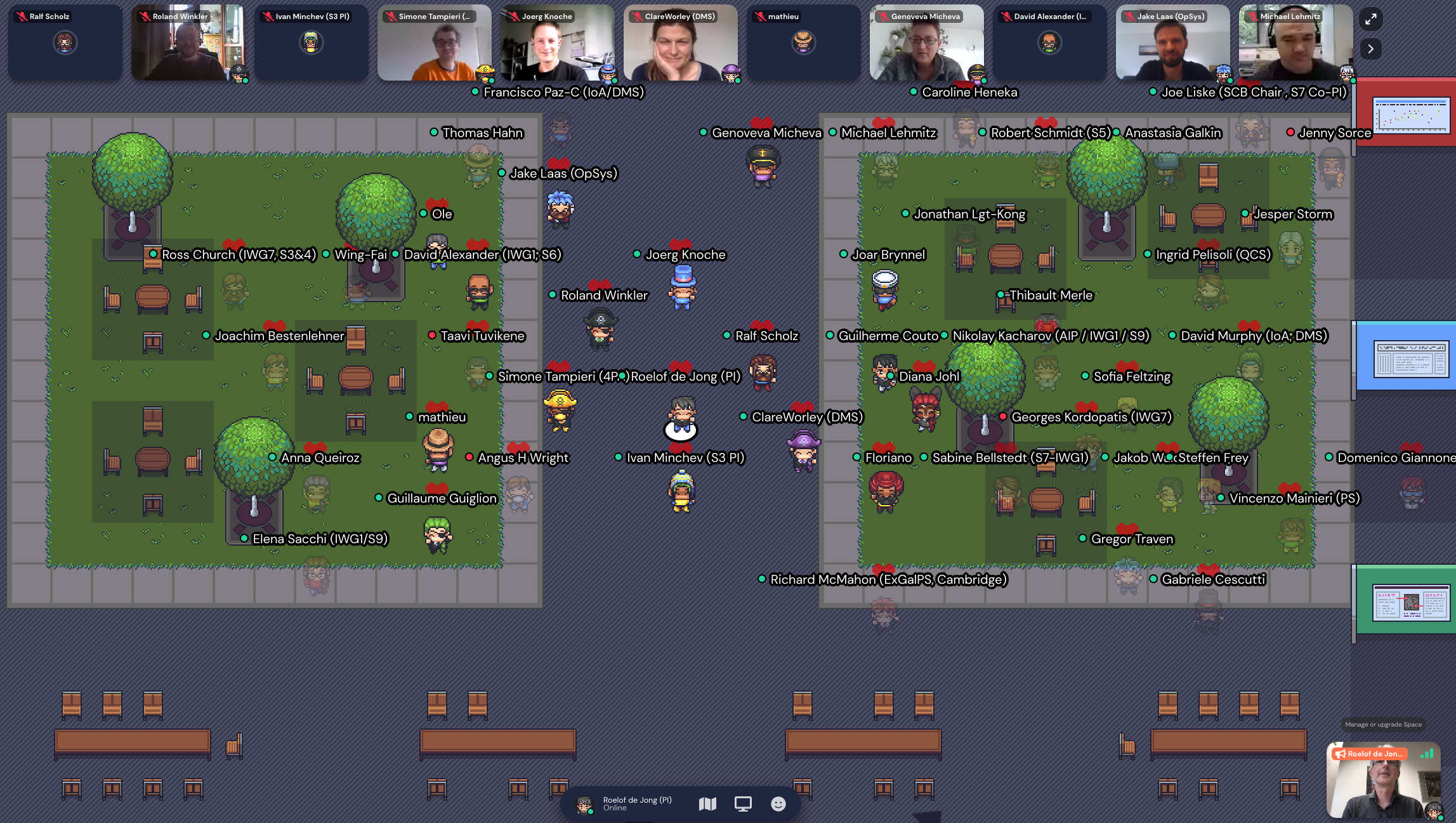
Final 4MOST Wide Field Corrector lens delivered
2021-07-19
The Project Manager, Joar Brynnel, is very happy to report that on 2021-07-15 the large lens "L1" for the 4MOST Wide Field Corrector (WFC) arrived safely at the UCL laboratory. Being the largest (900 mm diameter) and most expensive optical element in 4MOST, this is the final WFC lens to arrive in London.
The raw material (so-called "blank") for this lens was procured from a US vendor in 2017, and then shipped to an optics manufacturer in New Zealand. Here the lens was machined, and in August 2018 it was shipped to a specialist in the US for the so-called aspherisation. This is a difficult manufacturing step that only very few suppliers worldwide are capable of, especially for a lens of this size. For various reasons, the aspherisation took much longer than anticipated, and the lens was returned to New Zealand only in November 2020. Here, the lens was thoroughly tested and found to be in spec. In December 2020, the lens started its next overseas journey, this time to a coating facility in the US. The optical coating was completed and accepted in July 2021, and the lens was then shipped to London where it is now safely stored and waiting to be integrated into the WFC. We are relieved to finally see this beautiful lens finished and having survived the long journeys across the planet!
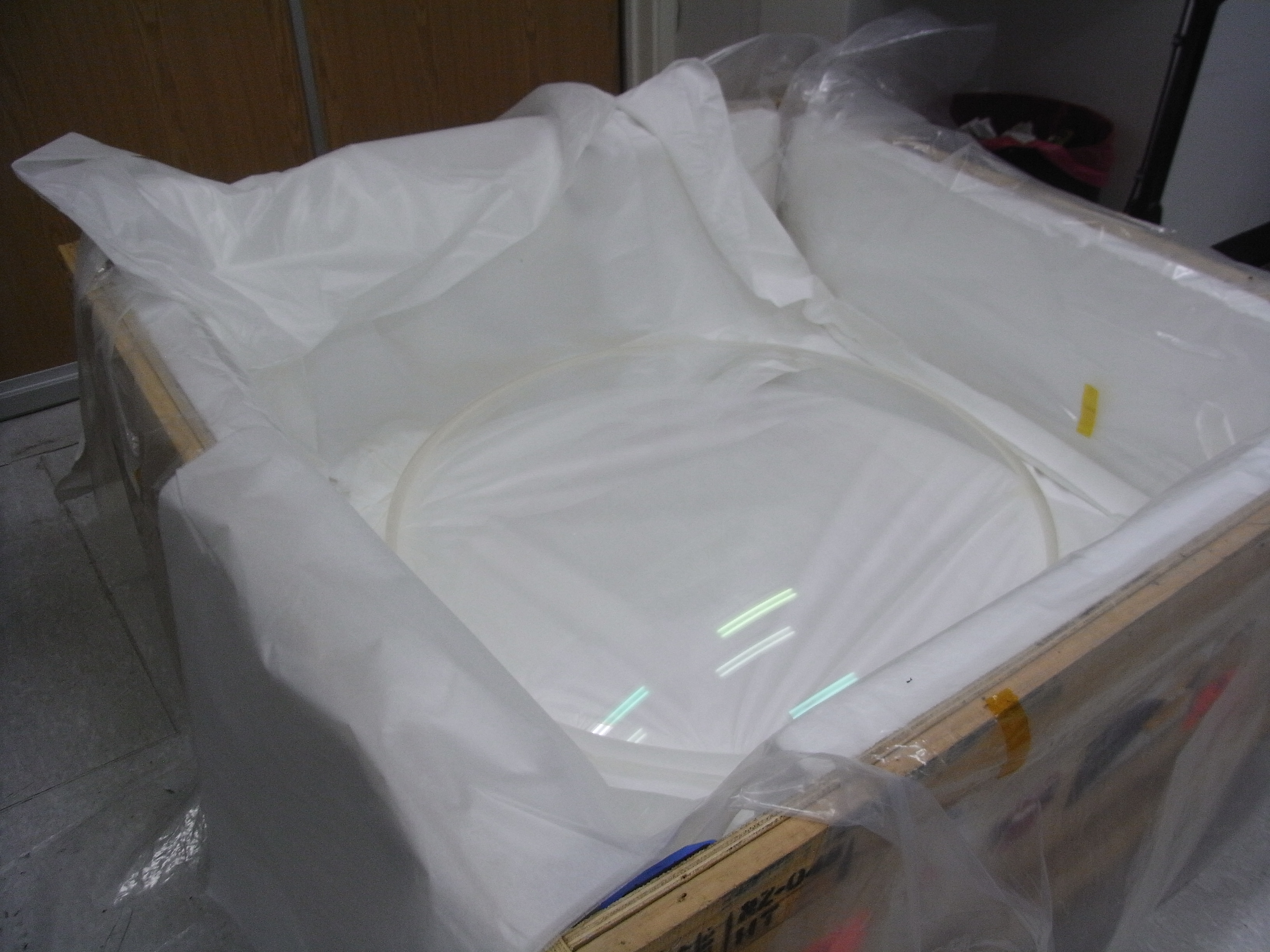
4MOST Cassegrain Cable Wrap arrives in Potsdam
2021-06-18
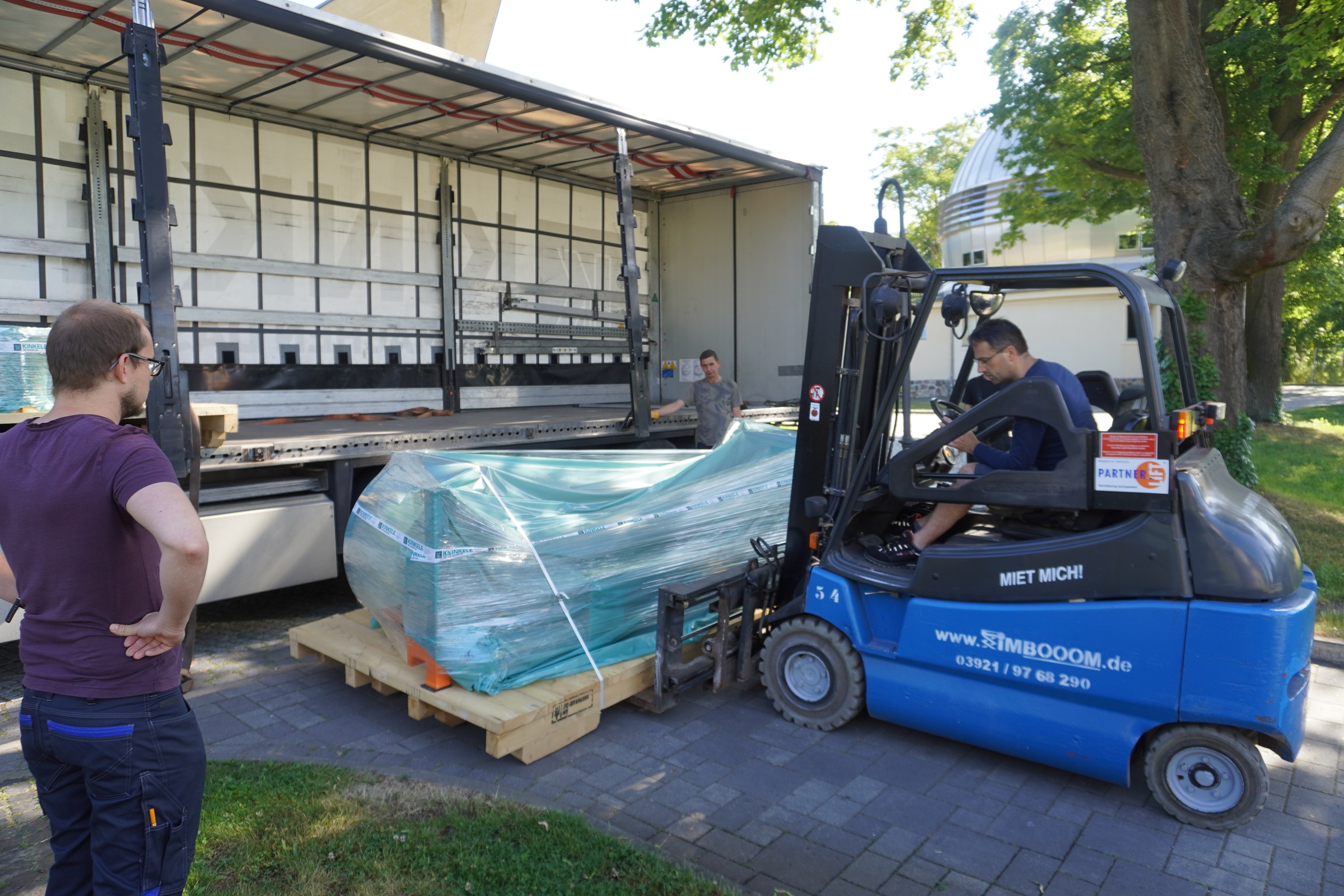
The Project Manager, Joar Brynnel, reports that on 2021-06-16 the 4MOST Cassegrain Cable Wrap (CaCW) was delivered to the AIP in Potsdam. The unit was transported from the manufacturer Kinkele in Bavaria on an over-wide transport truck. After unloading and unpacking in the 4MOST integration hall, the CaCW (white structure in the photos below) was mounted in its orange handling frame. Everything went smooth and without incidents.
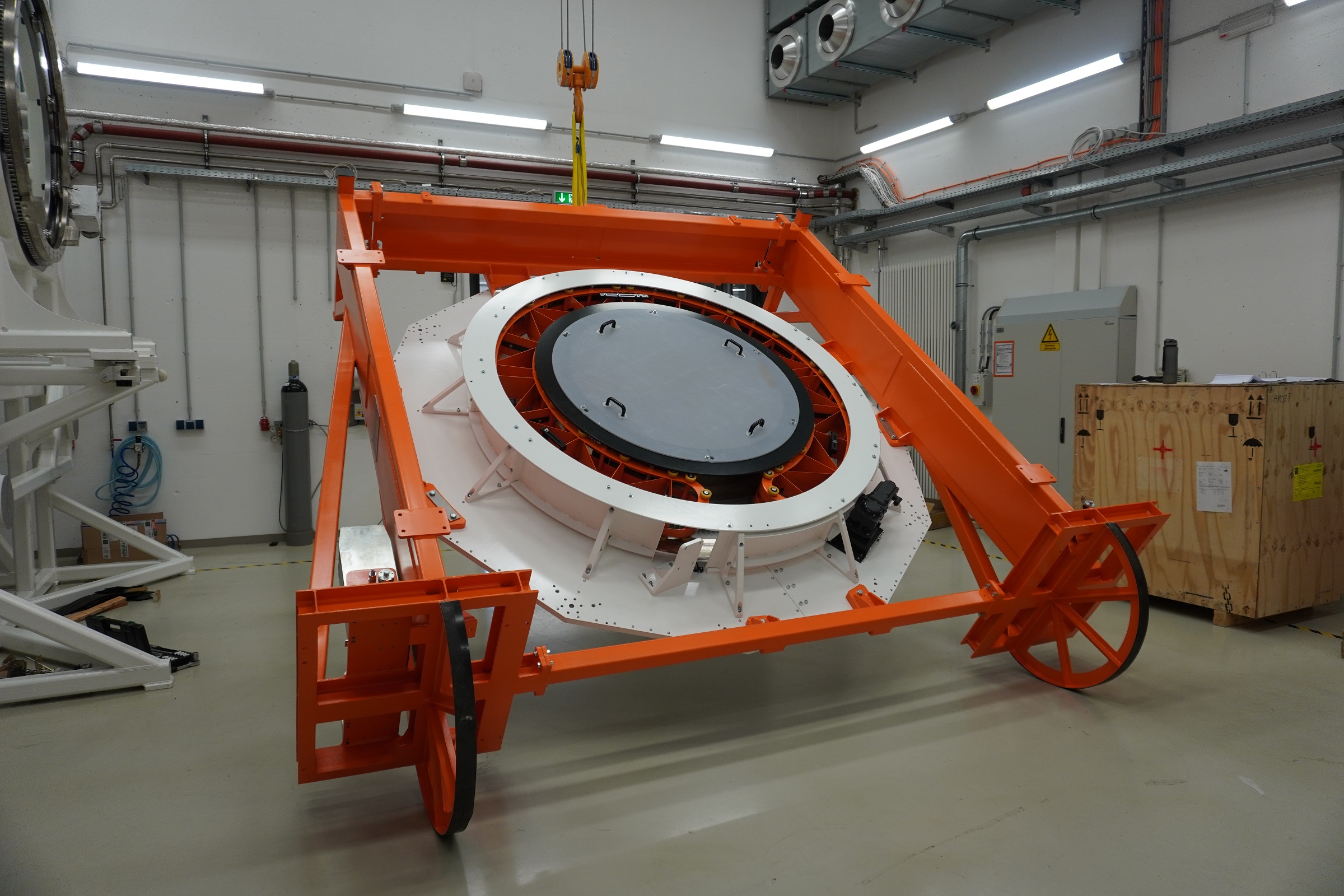
4MOST Cassegrain Cable Wrap Factory Acceptance
2021-05-17
The production of hardware for 4MOST is in full swing. One of the major electro-mechanical systems in production is the 4MOST Cassegrain Cable Wrap (CaCW). This system is required to de-rotate not only electrical, network, and cooling supplies to the fiber positioner AESOP, but also all optical fibers connecting AESOP to the three spectrographs. On the telescope, we have to rotate AESOP to track the stars on sky, and we need a way to safely manage all these connections to the Azimuth platform. The way we do this is through an electrically driven de-rotator. The detailed design, analysis, parts machining and assembly was contracted to the company Kinkele in the north of Bavaria. After completion, staff from the AIP spent three weeks on site at Kinkele to inspect and verify the CaCW. The campaign was successful and concluded with a punch list of issues to resolve before shipping to the AIP, which is scheduled for the first half of June 2021.
Allar Saviauk, CaCW lead engineer: "I was happy to see the CaCW structure finally in front of us after so many years of development and hard work. This system took several design revisions and tweaks before we were confident submitting it for manufacturing. We showed up at the manufacture's plant with our long test plan, and over a two and a half week period we were able to check all the dimensions, welds, load testing and of course the functionality itself. The first time we rotated the fully loaded system with chains was quite exiting! Fortunately, the CaCW works as intended and we were able to rotate this Stargate-like system by +/-200 deg in various telescope pointing angles. Some optimization is still required in the fibre cable configuration inside the energy chain. Our fibre team is currently working on a solution. The company is also re-manufacturing one of the welded assemblies to improve the dimensional fit to other components. In general I'm very pleased about the results and want to thank everybody involved with this system over the years: A. Kelz, J. Brynnel, S. Bauer, T. Jahn, L. Wagner, J. Paschke, R. Haynes, T. Liebner (AIP), M. Lehmitz (MPIA), and A. Jost (ESO)."
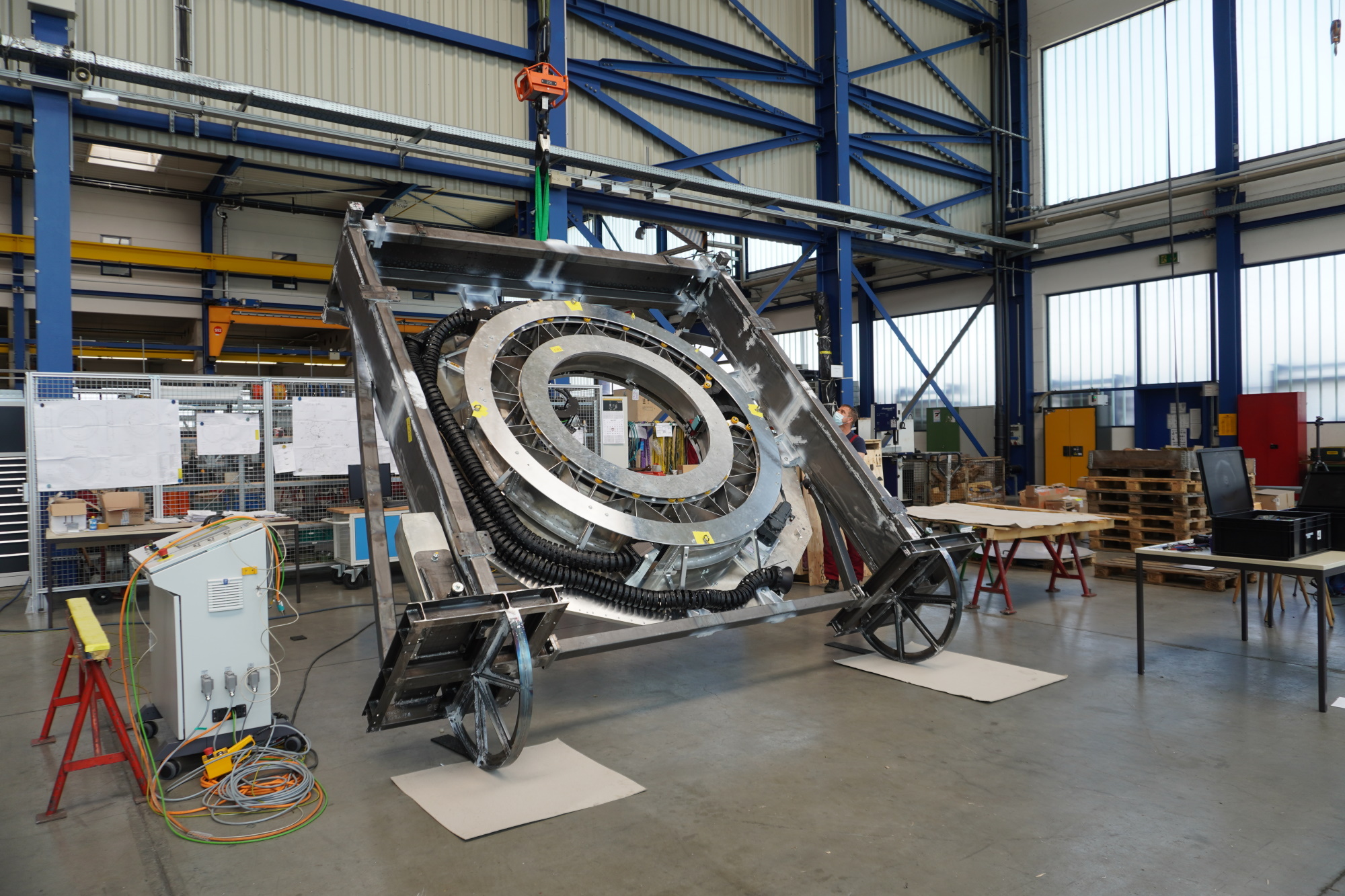
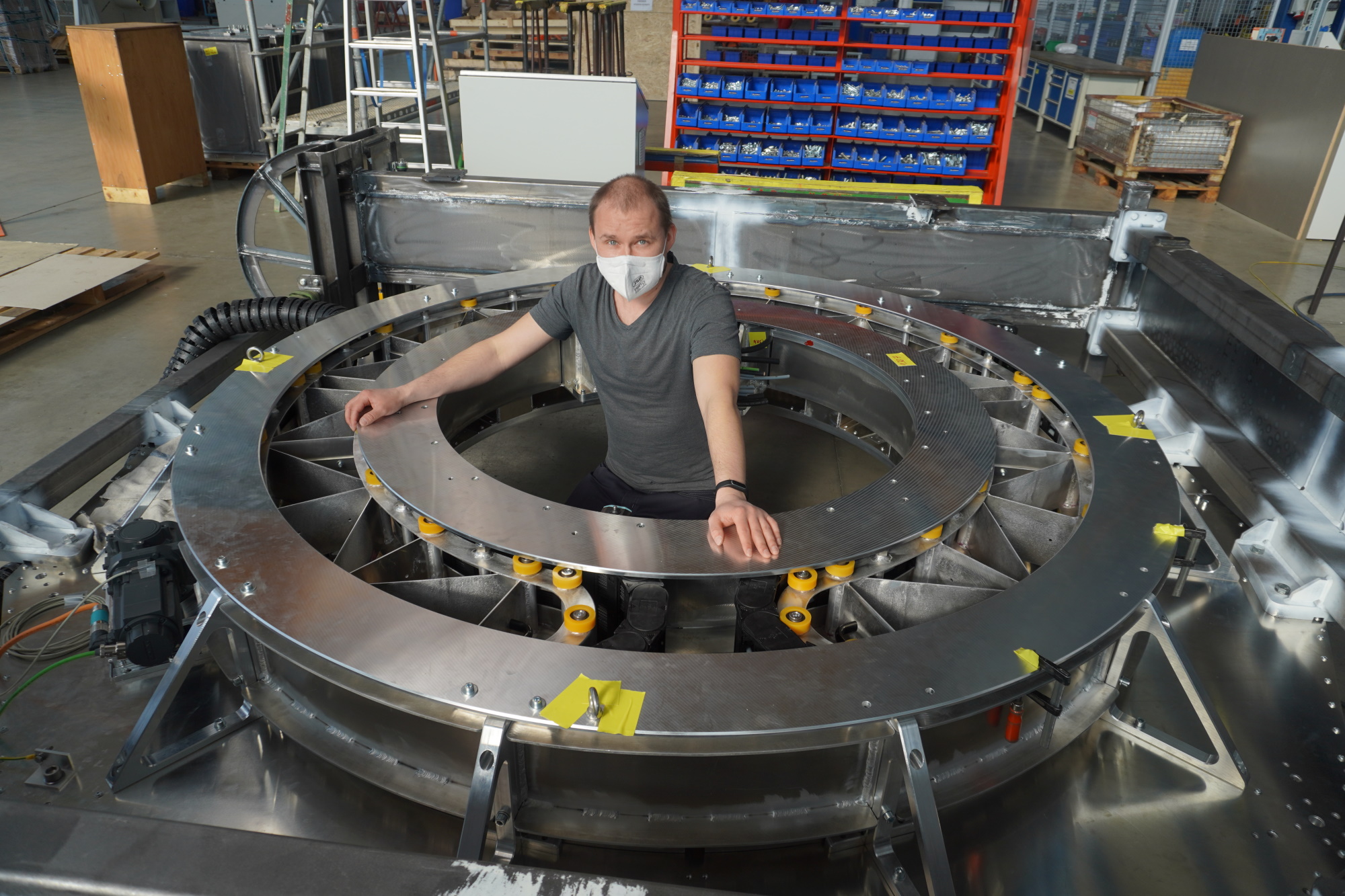
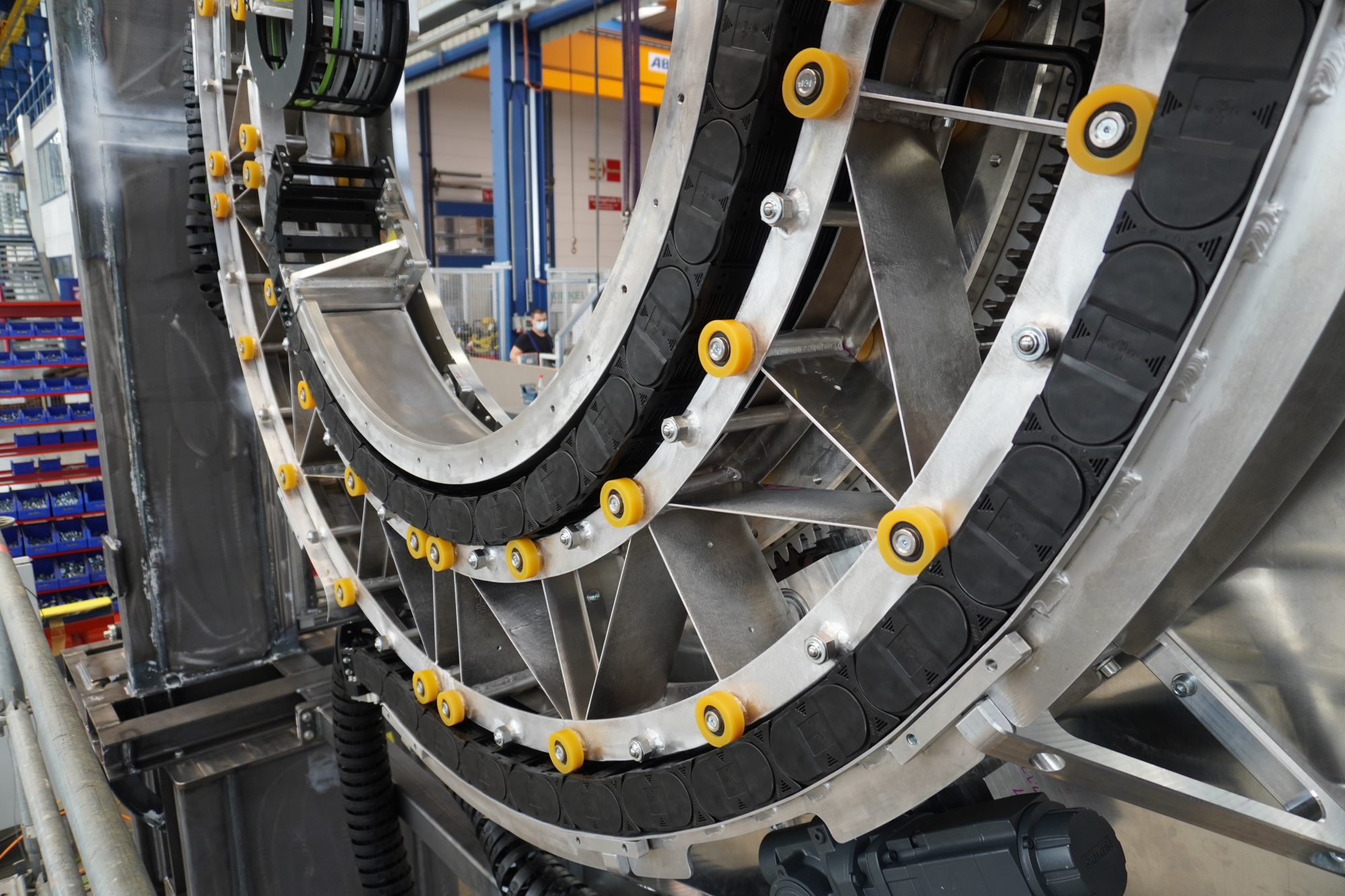
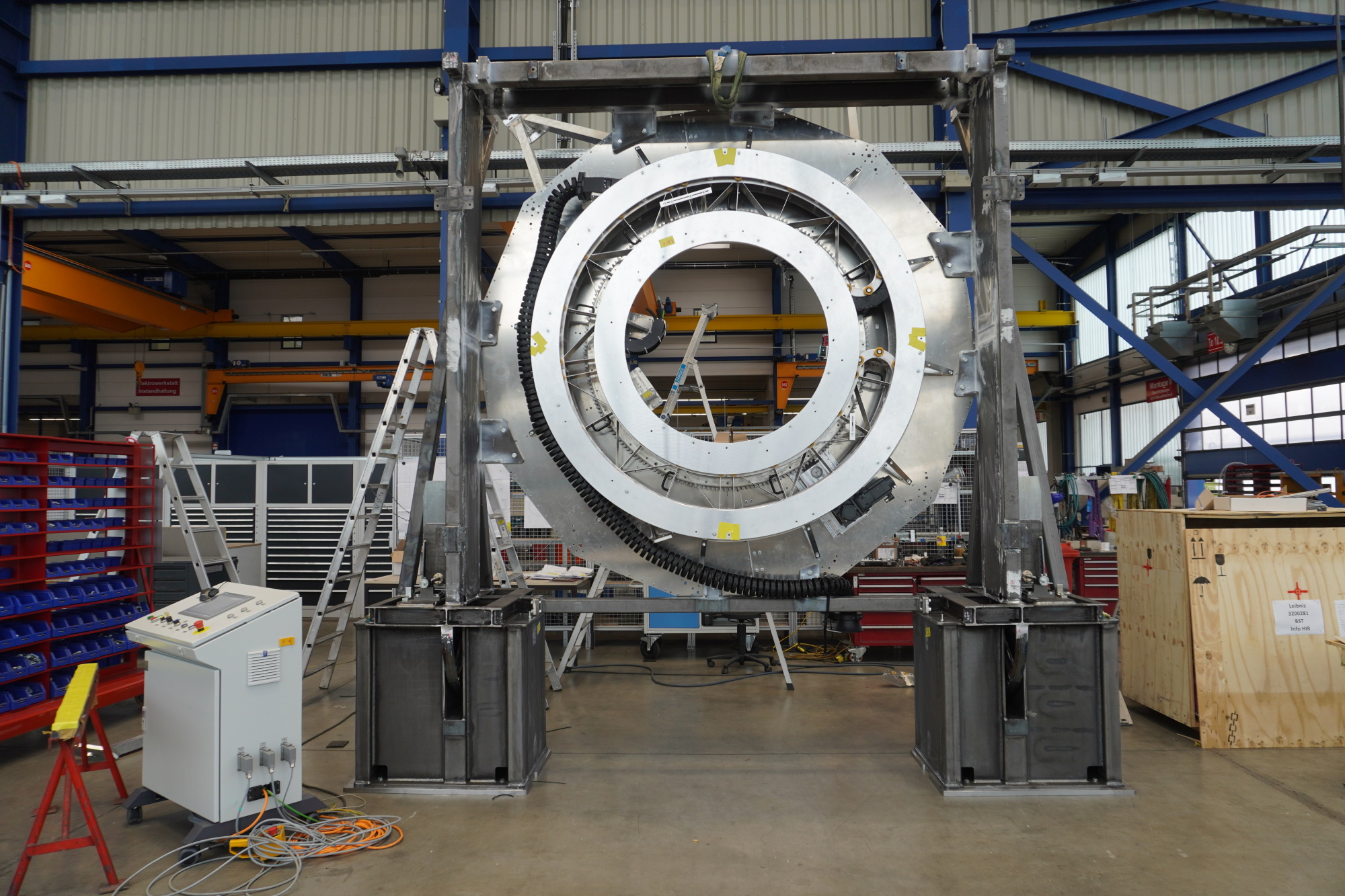
First LRS spectra
2021-03-14
The first 4MOST Low-Resolution Spectrograph (LRS-A) has now reached "first light" (or first spectra) in the CRAL integration hall in Lyon, France. These first exposures were taken through the blue channel. The most important parameters – image quality, wavelength range and spectral resolution – are all very close to those necessary to meet our goal of doing world class astrophysical research. The LRS opto-mechanical design preforms well, giving us confidence that similar performance will be achieved when assembling the green and red channels of LRS-A, and the second LRS.
Florence Laurent, the head of engineering at CRAL: "I am happy to say that the first arm of LRS-A has been integrated and aligned and we succeeded in making the first exposures. Most importantly, the blue channel already performs close to its scientific and technical specifications. I would like to express my sincerest thanks to the team, Karen Disseau, Jean-Emmanuel Migniau, Didier Boudon, Diane Chapuis, Eric Daguisé, Aurélien Jarno, Arlette Pécontal, Johan Richard, and Alban Remillieux, all of whom overcame many challenges to reach this milestone."
Matthew Lehnert, the director of CRAL, added: "It's wonderful to see these results and imagine the exciting scientific results and breakthroughs we will be capable of making with this extremely capable instrument. Without the hard work of the dedicated team at CRAL, imagining these goals would not even be possible. Thank you to everyone for their hard work!"
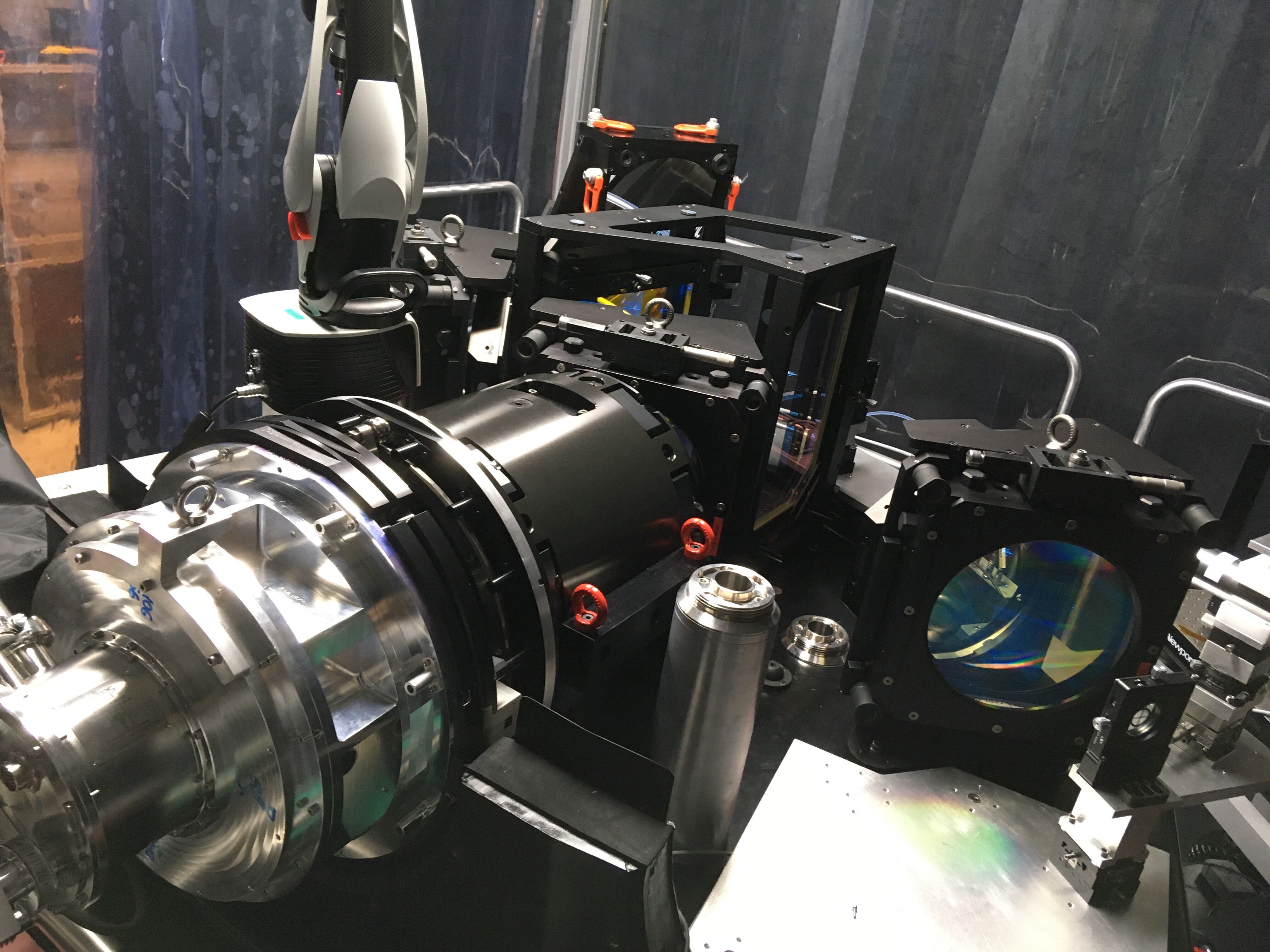
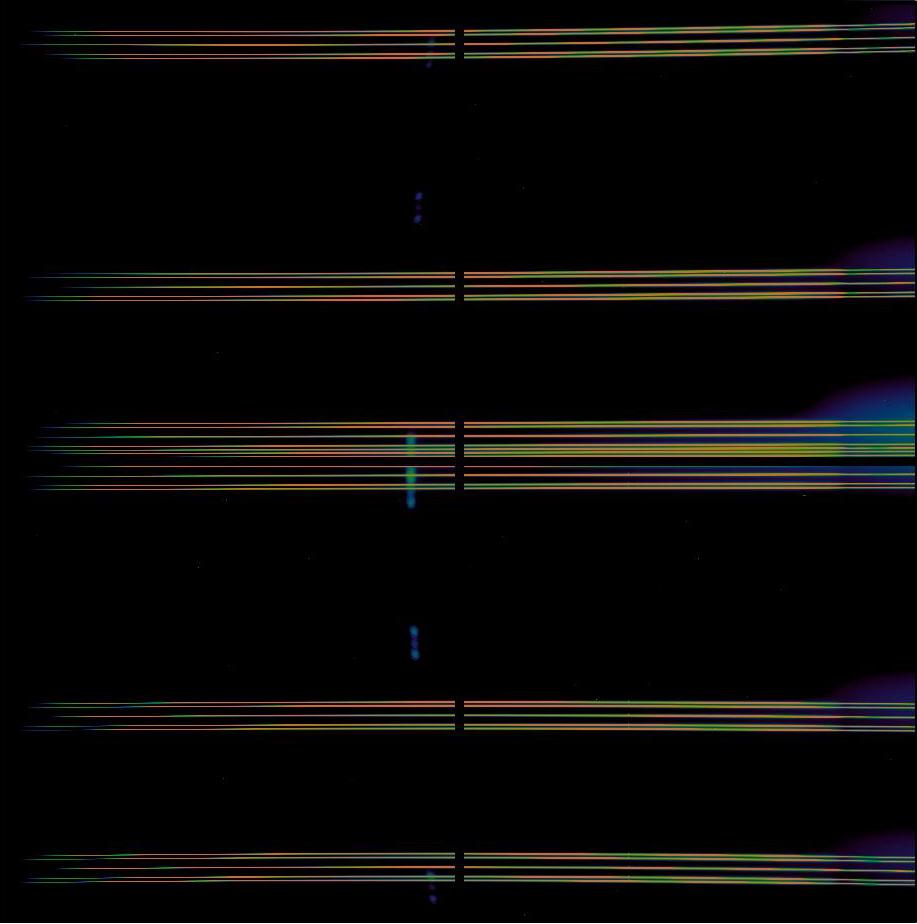
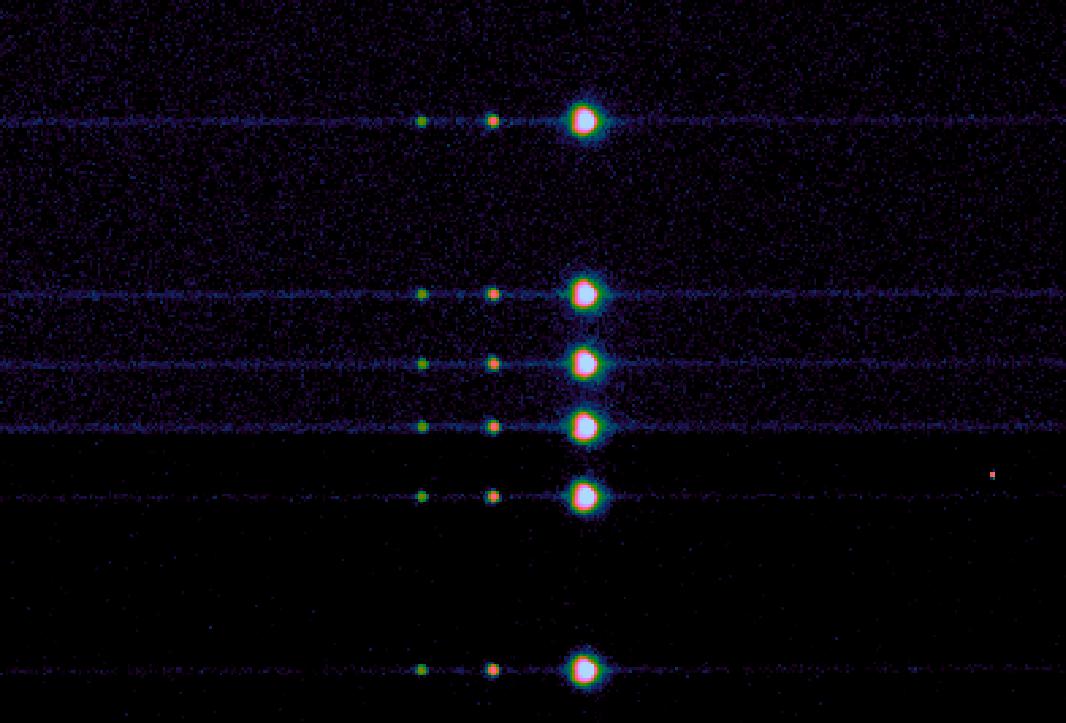
4MOST proposals submitted to ESO
2020-12-15
On 15 December 2020 the 4MOST consortium and the ESO community successfully submitted their proposals for ESO Public Surveys to be carried out with 4MOST during its first five years of operations. While the consortium submitted 10 proposals for its guaranteed time (corresponding to the 10 Consortium Surveys), the community submitted 18 proposals to compete for the "open" time available to the community.
The proposal submission marks the culmination of many months of preparation. The community proposals were invited by ESO following a pre-selection based on Letters of Intent previously submitted by the community in February 2020. While honing their own proposals over the past months, the 4MOST Science Team also supported their colleagues in the ESO community to get ready and plan for the exciting scientific opportunities offered by 4MOST, e.g. by organising two workshops. The proposal submission thus represents yet another major milestone for the 4MOST project and the Principal Investigator, Roelof de Jong, would like to thank everyone involved for their hard work and strong commitment.
ESO's Public Survey Panel (PSP) will now review all proposals received and judge the community proposals in terms of their complementarity and possible synergies with the Consortium Surveys before recommending the final, joint 4MOST Survey Programme.
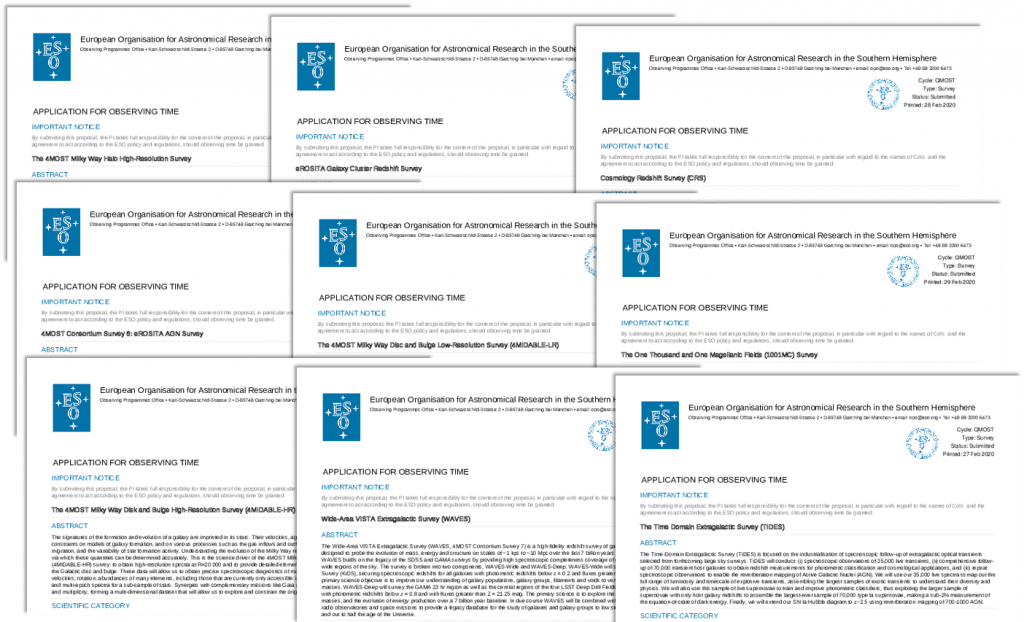
4MOST first spectra
2020-12-04
The 4MOST High-Resolution Spectrograph (HRS) has now reached "first light" (or first spectra) in the Landessternwarte (Heidelberg) lab for the green channel with an engineering grade detector. This is not only a major and exciting milestone for the project in general, but it also means that for the first time we have real HRS data to work with after many years of working with simulated data. It is also a validation of many aspects of the 4MOST opto-mechanical design, which allows the project to move forward with the remaining MAIT activities with increased confidence.
Walter Seifert (HRS Lead Engineer) reports: "The basic alignment of the channel with regard to wavelength range, image quality and spectral resolution has been performed in two days without any issues. Further iterations on optimising the performance will be done with the actual science detector in place. Nevertheless, the spots are already in or close to specification. Apart from flatfield and spectral arc exposures using the lab calibration unit, we also took a spectrum of the sun by holding an auxiliary fibre out of the window towards the sky."
Roelof de Jong (4MOST PI) commented: "I am very excited to see these first spectra from the High-Resolution Spectrograph. It is wonderful to see that within a few days of effort the team is already meeting most specifications. This gives great credit to the many excellent people involved from across the consortium: the HRS team of course, but also the detector and control hardware teams, the fibre team, and now the data management system team. I want to thank them all for their dedicated efforts."
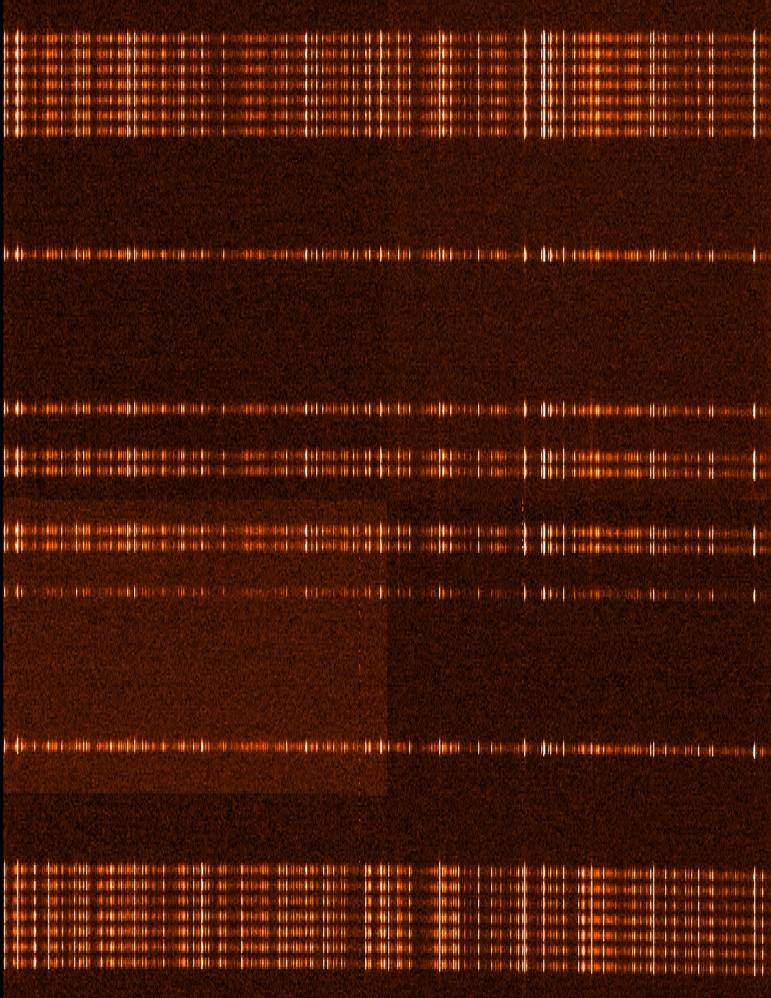
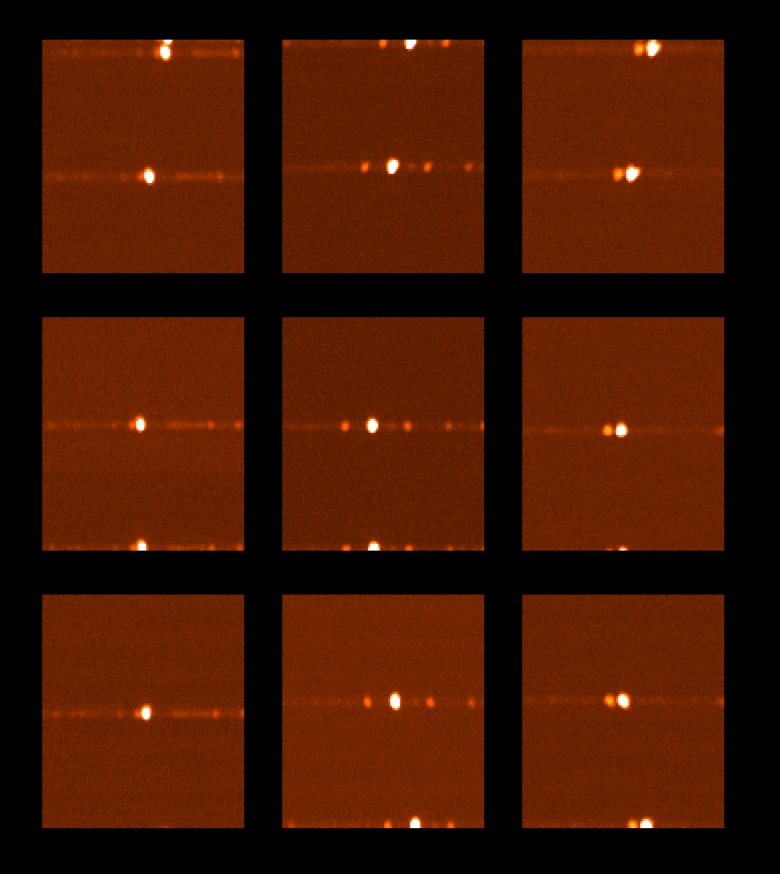
Left: HRS spectrum of a ThAr lamp. The full wavelength range of the green channel (516 – 573 nm) is shown for a few central fibres. Right: image quality test using the ThAr spectra. Shown are 100 × 100 px at the four corners of the detector as well as some intermediate points.
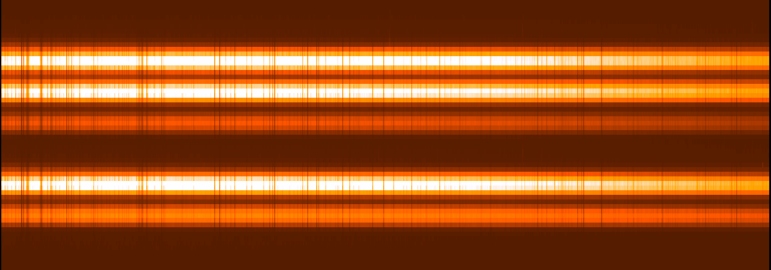
4MOST Wide Field Corrector optics delivered
2020-11-27
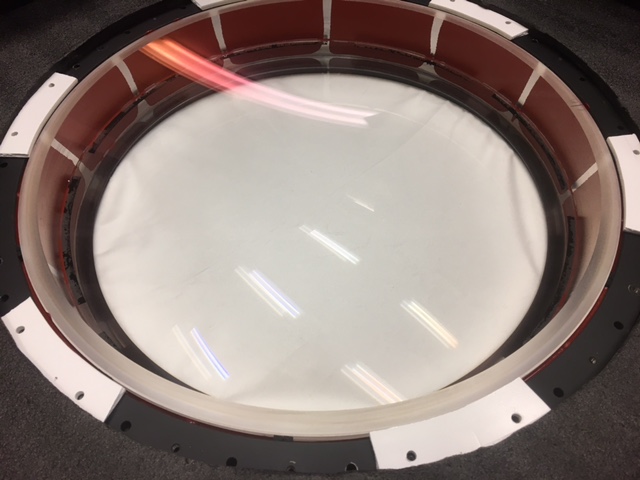
The 4MOST Wide Field Corrector (WFC) and Atmospheric Dispersion Corrector lenses have been manufactured and tested at KiwiStar Optics, New Zealand. These are large lenses that represent a significant part of the overall hardware budget for 4MOST. The Project Manager, Joar Brynnel, is pleased to report that five of the six WFC lenses have just arrived safely at the UCL laboratory, where they will be integrated with the WFC mechanics and aligned with high precision in order to meet their tight specifications. The sixth lens is still at KiwiStar in the final stage of manufacturing. It is a great relief for the project that the lenses have arrived without damage. Peter Doel (UCL) reports: "The crates have arrived safely and are under lock and key in the lab. No external shock indicators were triggered and there was no visual damage of the boxes. We very briefly (and without taking them out of the boxes) did a visual inspection of the lenses before resealing them. The lenses look fine."
Changes to Survey leadership
2020-10-20
The science programme of 4MOST is driven by its individual Surveys, each pursuing different science cases. Currently, there are ten such Surveys to fill the Guaranteed Time Observations of the Consortium, each under the leadership of one or more Survey Principal Investigators (PIs). After 10 years of serving as Survey co-PI of the Milky Way Halo Low-Resolution Survey (S1), Prof. Amina Helmi has unfortunately decided to resign from this position. The 4MOST Project is very grateful for her leadership since the start of the project and for bringing the Survey to its current excellent state together with her S1 co-PI Prof. Mike Irwin. Amina is looking forward to seeing data arrive in a few years' time and will remain involved in the further development and exploitation of the Survey. We wish Amina all the best for her other endeavours and the responsibilities she has taken on.
Fortunately, Amina's resignation will not leave a vacancy. The Project is extremely pleased that the 4MOST Executive Board has approved the nomination of Prof. Else Starkenburg as the new co-PI of the Milky Way Halo Low-Resolution Survey at its meeting on 15 October 2020. This is expected to be a fairly smooth leadership transition, as Else already served as one of the co-PIs of S3, the Milky Way Disc and Bulge Low-Resolution Survey (4MIDABLE-LR), in the past, and is hence already familiar with the required background. While Else will remain active within 4MIDABLE-LR, its leadership is now in the hands of the remaining S3 Co-PIs Dr. Cristina Chiappini and Dr. Ivan Minchev.
The Project would like to thank everyone involved in this transition for the excellent leadership provided so far, and is looking forward to the continued collaboration toward the final development of the survey programme, science operations and data exploitation.
4MOST All Hands Meeting 2020
2020-10-12

The 4MOST Consortium came together on 05 – 09 October 2020 for its sixth annual All Hands Meeting (AHM). Originally planned to be held at ESO in Garching, the ongoing Corona pandemic forced the event to be held entirely online.
The AHM brought together consortium members working to define, construct, operate and scientifically exploit the 4MOST Facility. This included the engineers, managers and scientists responsible for the delivery of the 4MOST Facility, the scientists planning the science operations in the infrastructure working groups, and the scientists from the large number of institutes involved in defining the ground-breaking consortium science surveys.
From a project management perspective, the project is generally in good shape. Funding for hardware is secured and a moderate contingency is available. The hardware budget has seen only a minor increase of about 2% over the past year. As already reported in this news channel, the project has incurred a schedule delay of 9 months as a result of Covid-19, this delay was however expected and is comparable to delays in other projects. It was noted that the three parts of the project (Facility, Operations, and Science) continue to be well synchronized schedule-wise. Sustained travel restrictions due to the pandemic means that many activities such as progress meetings and acceptance testing have to be re-cast into a remote format. The project risk register was updated during the AHM, some risks could be retired, and several risk indexes were updated.
On the facility side of the project, a particular focus of the meeting was to discuss and coordinate subsystem and system integration activities. The thrust of discussions was distinctly different from that of the past AHM, showing that we are making progress towards the system testing phase at the AIP. Substantial effort has gone into preparing the AIP infrastructure for carrying out the system-level testing between now and Preliminary Acceptance Europe (PAE).
The Operations Development Group (ODG) used the AHM to make progress in two essential directions. In the area of observation preparation, the front-end, new simulations run with the 4MOST Facility Simulator (4FS) were presented and discussed extensively. As more functionality is added to the 4FS discussions tackled both possible tweaks to the survey strategy and the surveys' target catalogues, as well as the development and understanding of algorithmic solutions to on-going issues. Concerning the overall data flow, ODG is currently running Operational Rehearsal 2, designed to run most pipelines for the first time on simulated-real data. All pipelines showed their current products. Discussions revolved around the necessary improvements in each pipeline to make those products "not-wrong", or, in other words, good enough to be sent onward to the next pipeline, while not necessarily being correct in all aspects yet. Other discussions at the AHM revolved around ways to add more resources to some struggling work packages, as well as closing the formal loop on operations requirements.
The meeting's programme can be found here.
